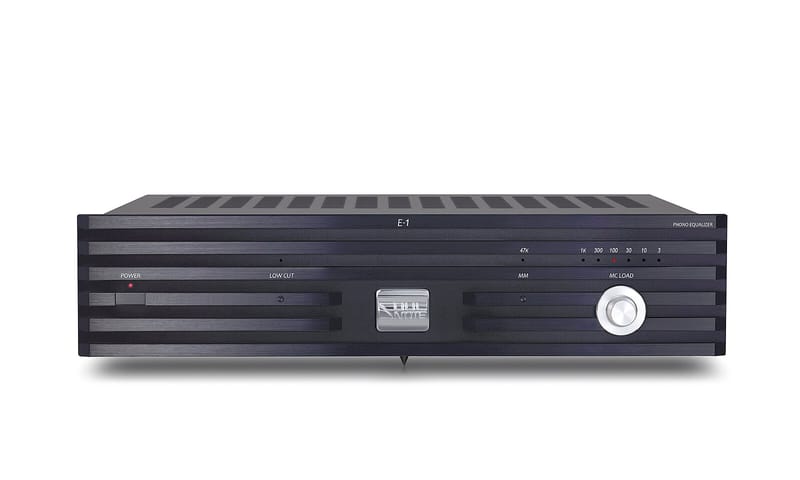Building upon the circuit layout of our legendary ph1.0 Phono Equalizer. An upgraded phono equalizer that pursues the unlimited possibilities of analog recordings.
- Category: Series 1
Description
 Phono Equalizer(SOULNOTE 10-year Anniversary Model)
Phono Equalizer(SOULNOTE 10-year Anniversary Model)
PLATINUM SILVER / BLACK
Building upon the circuit layout of our legendary ph1.0 Phono Equalizer.
An upgraded phono equalizer that pursues the unlimited possibilities of analog recordings.
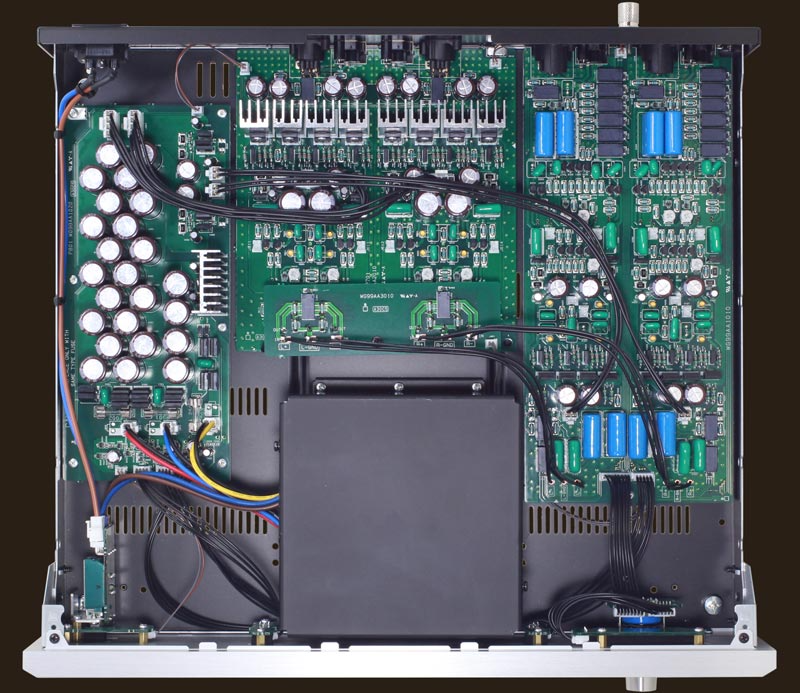 Perfectly balanced, discrete non-NFB phono equalizerThe biggest advantage of non-NFB amplifiers is the exceptional transient responsiveness they obtain by indefinitely extending the high range. Non-NFB amplifiers provide even more benefits with analog sources, which essentially have no range limitations. The E-1 is built upon the circuit layout and components of our legendary ph1.0 Phono Equalizer and has refined the finer points of that model. By including RIAA elements in voltage amplification circuit loads, the E-1 features a unique circuit system that makes gain itself an RIAA characteristic and obtains uniform quality throughout the entire frequency range above 100 kHz, thus eliminating the drawbacks of both CR types that have problems with dynamic ranges at the high end and NF types that change NF volume depending on the range. The CR components use MELF with 1% accuracy and polypropylene film capacitors with 2% accuracy for perfect curve characteristics. The result is a phono equalizer with the soul of the ph1.0 and remarkable augmentation of clarity, information, and sonic realism.
Perfectly balanced, discrete non-NFB phono equalizerThe biggest advantage of non-NFB amplifiers is the exceptional transient responsiveness they obtain by indefinitely extending the high range. Non-NFB amplifiers provide even more benefits with analog sources, which essentially have no range limitations. The E-1 is built upon the circuit layout and components of our legendary ph1.0 Phono Equalizer and has refined the finer points of that model. By including RIAA elements in voltage amplification circuit loads, the E-1 features a unique circuit system that makes gain itself an RIAA characteristic and obtains uniform quality throughout the entire frequency range above 100 kHz, thus eliminating the drawbacks of both CR types that have problems with dynamic ranges at the high end and NF types that change NF volume depending on the range. The CR components use MELF with 1% accuracy and polypropylene film capacitors with 2% accuracy for perfect curve characteristics. The result is a phono equalizer with the soul of the ph1.0 and remarkable augmentation of clarity, information, and sonic realism.Perfectly balanced circuits (at MC input)
The E-1 fully supports balanced cartridge input. The rear panel includes an operation selector and comes complete with balanced input XLR terminals. When using XLR two-core shielded cables for balanced inputs, the E-1 becomes a perfectly balanced non-NFB phono equalizer from input to output.
This creates an overwhelming soundscape that expands in three dimensions and sounds with a delicateness that will resonate in your soul.
Note: Setting the operation selector to balanced RCA inputs allows for balanced inputs, but it is effectively an unshielded setup and some noise may be produced. We recommend always using XLR two-core shielded cables. Also, please note that the operation selector is not an input selector. To ensure the best sound quality, the HOT RCA terminal and the 2nd XLR terminal pin are connected internally, as are the COLD RCA terminal (GND) and the 3rd XLR terminal pin.
As a result, it is impossible to switch between two record players connected to the RCA and XLR terminals.
* The default setting is unbalanced (NORMAL)
Input load impedance selection feature (LOAD selector)
Choose between 1k ohm, 300 ohm, 100 ohm, 30 ohm, 10 ohm, and 3 ohm. (for MC input)
MM input
Pressing the MM button enables the use of MM cartridges and MC boosting transformers.
Ultra-low range cutoff (subsonic filter)
Turning the LOW CUT switch ON reduces woofer movement as a result of record warping, etc.
Ultra-powerful balanced output
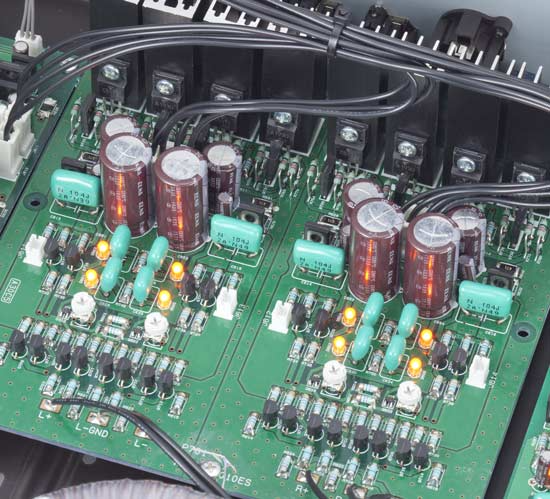 A strong, balanced output is obtained by providing a fully balanced non-NFB buffer amplifier that is even capable of driving loudspeakers.Unbalanced outputs are output only through the HOT balanced output, just like with other SOULNOTE products.
A strong, balanced output is obtained by providing a fully balanced non-NFB buffer amplifier that is even capable of driving loudspeakers.Unbalanced outputs are output only through the HOT balanced output, just like with other SOULNOTE products.Strong toroidal power supply transformer & non-NFB power supply
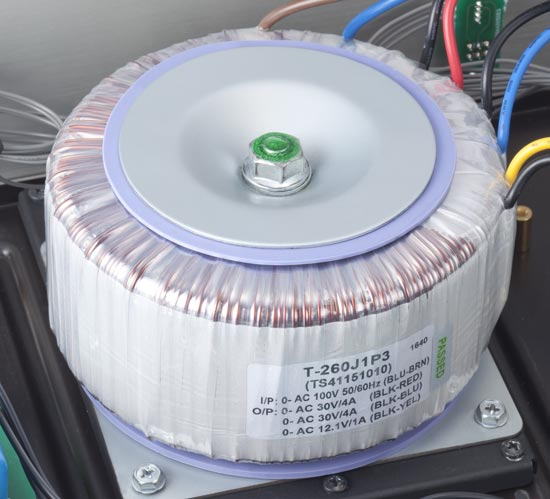 The E-1 incorporates 260 VA toroidal transformers with the same specifications as those used in the A-1 Integrated Amplifier. Darlington ripple filter circuits, fast recovery diodes, and 10 parallel 1,000 μF filter capacitors combine in a non-NFB power supply that creates an inexhaustible sense of lightness.
The E-1 incorporates 260 VA toroidal transformers with the same specifications as those used in the A-1 Integrated Amplifier. Darlington ripple filter circuits, fast recovery diodes, and 10 parallel 1,000 μF filter capacitors combine in a non-NFB power supply that creates an inexhaustible sense of lightness.Direct mechanical grounding construction
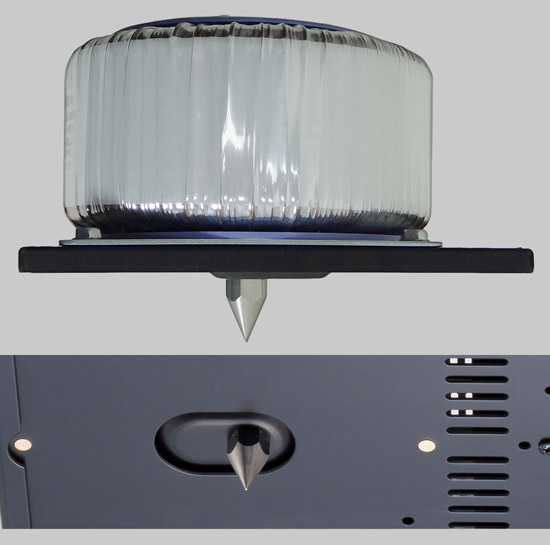 Supported by three spikes, one on the front side and two on the rear side. In this way, the spike pins can be placed directly under the transformer, and mechanical grounding can be achieved to allow harmful transformer vibrations to escape directly out of the chassis.As a result, the fuzziness of the sound caused by chassis dumps can be removed and the soul of sound can be reproduced.
Supported by three spikes, one on the front side and two on the rear side. In this way, the spike pins can be placed directly under the transformer, and mechanical grounding can be achieved to allow harmful transformer vibrations to escape directly out of the chassis.As a result, the fuzziness of the sound caused by chassis dumps can be removed and the soul of sound can be reproduced.Metallic insulators as standard equipment (when under load)
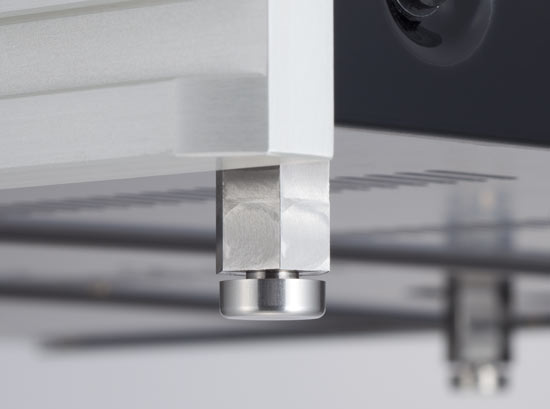 Though plastic insulators are the conventional standard, we now use metallic insulators since they promote higher sound quality.
Though plastic insulators are the conventional standard, we now use metallic insulators since they promote higher sound quality.Specifications
Model name E-1SE(PLATINUM SILVER)/E-1BE(BLACK)
Input sensitivity MC:0.5mV , MM:5mV
Load resistance MC:3ohm , 10ohm , 30ohm , 100ohm , 300ohm , 1kohm / MM:47kohm
Gain MC:70dB , MM:50dB
Rated output Balanced output:2.8V , Unbalanced output:1.4V
RIAA deviation ±0.3dB
Power voltage 230V AC 50Hz
Power consumption 48W
Maximum external dimensions Main unit: 430(W)×109(H)×409(D)mm
Weight 9.5kg
Included accessories Spikes,Power cord
Rear panel

Included accessories
Spikes,Power cord

